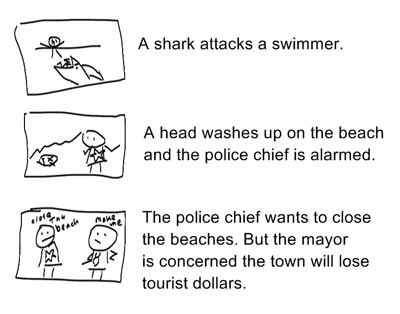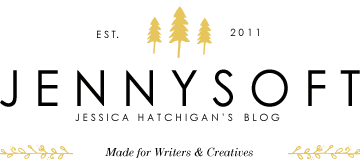Are you struggling with plotting your novel?
Here’s one approach that can help break a creative logjam – storyboard your plot.
What is storyboarding? It’s combining sketches of key action scenes with a brief description of what is going on in the action scene.
Take a look at the example.

Three key scenes (also known as “beats”) from the beginning of the novel Jaws are storyboarded. The scenes include: 1) A swimmer is attacked by a shark. 2) Body parts wash up on the beach. 3) The police chief wants to close the beach, but is opposed by the mayor who doesn’t want the town to lose tourist dollars.
For purposes of plotting a novel, you don’t need any particular skill as an artist. A writer can make stick figure thumbnail sketches, as shown. But the value add for the writer is that you now have a visual element to work with. For some of us, this is very helpful. I know it is for me.
Here are a few additional tips for taking a storyboard approach to writing your novel:
- Start by creating eight one-sentence descriptions of your story’s eight key scenes (or, story “beats”). These are the Wow! scenes in your novel – when something spectacular/interesting/emotionally wrenching/gripping (well, you get the idea) happens. Movies are planned this way – around eight or so key scenes.
- Next, “fill in the blanks” (i.e., add one-sentence descriptions of the remaining 50+ scenes that will make your eight “Wow” scenes flow together beautifully.) A typical novel has about 60 scenes of 4 to 5 pages in length, on average. Now that you’ve outlined your eight key absolutely amazing scenes, noodle out the 52 other scenes that weave those Big scenes together- that lead up to and out of each of those key scenes. Write a one-sentence description for each of these scenes, or beats. Can you see how taking this visual approach – storyboarding – offers your creativity additional good stuff with which to to work?
And there’s an additional “value add” to taking the storyboard approach to plotting: It’s fun!
Check out my related blog post on How to Write a Pageturner Novel ‘Beat Sheet’ for more on how to plot your story, check for story holes, and ensure yourself that you’re creating a page-turning narrative, before you invest the time it will take to write the 40- to 60,000 words that comprise an average novel.
Storyboard art: Jessica Hatchigan

4 Comments
Thanks for this. Soooo helpful and Im very happy to have found your blog, as an amateur writer who is just learning the ropes, a blog like this is invaluable. I am always humbled by people like yourself who take the time to pass on your wisdom and experience. Thank you.
This is a great example! I’m a learning specialist at Star Academy in San Rafael, and I’d love to use your graphic as an example if you don’t mind!
Please feel free.
Thanks so much for this! I am working on three projects right now and my normal storyboarding/outlining process takes place in my head, but one of my projects is more a challenge to myself and I have been stumped as to how I should proceed. The storyboarding will help a lot and I think I am actually going to incorporate it in with the other stories I already have started.